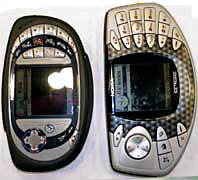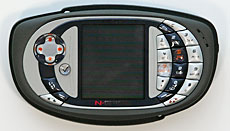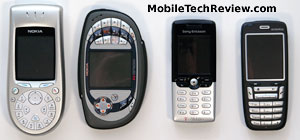Nokia N-Gage QD GSM Phone and Game Deck
When is a mobile phone not just a mobile phone? When it's the Nokia N-Gage QD "Game Deck". Sure, mobile phones can be smart, offering some of the same features found on PDAs. They can all play games, but the ergonomics aren't up to snuff for an hour of action-riddled fun. The N-Gage QD aims to change that, with a design befitting a handheld game console that somehow manages to work well as a phone.While the original N-Gage (no QD at the end of its name) acquired a collection of descriptive phrases such as the taco and side talkin' thanks to its ungainly design and oddly mounted speaker and mic which required you to hold it on end to talk, the QD is a new animal. Not that the innards have changed much, but the exterior has been completely redesigned. The QD is smaller, looks slick, works well for gaming and phoning and best of all: you hold it normally, flat against your ear and face to have a conversation.
Besides its impressive gaming capabilities, perhaps the most attractive thing about the N-Gage QD is its price. Symbian Series 60 GSM phones are generally pricey, but the N-Gage QD is a wildly affordable Series 60 beast with Bluetooth. What is Symbian Series 60? The Symbian operating system is the most widely used cell phone OS. Series 60 is at the high end of the Symbian OS lineup, offering several PDA-like features, an expansion slot for memory, and the ability to install add-on programs of all sorts (there are more than a thousand available). Such power comes at a price, and Series 60 Nokia phones generally cost between $300 to $500 US. The QD sells in the US for somewhere between free and $149 with activation and an unlocked version for use with any GSM carrier sells for $199 (no contract commitment required).
Not bad! Of course, the N-Gage targets kids who love gaming along with adults. That means the device had to be relatively inexpensive. To keep costs down, Nokia didn't load this with some of the features you'll find on their more expensive Series 60 phones such as the Nokia 7610 or 6620. The QD has only a 4,096 color display rather than the usual high end 65,000 color display (though games look very good), it lacks a camera and there is no cable syncing option and no IR port, so you'll need to suffer through Bluetooth syncing if you need to get your Outlook data onto the phone. If you can live without those features, are on a budget, or best of all are a hardcore gamer who doesn't want to carry two devices or be seen with a Nintendo DS on the commuter train, read on.Design and Ergonomics
The QD looks like no other cell phone. That's a good thing, since the device doubles as a handheld game deck. Not a flip, not a candy bar, not even a taco; the QD fits well in the hand for use as a phone but has an overall design reminiscent of a game controller. The excellent 5-way directional pad lives on the left and the number pad (also used in gaming) is to the right of the color display. It feels great in the hand when gaming and the controls work perfectly. The d-pad supports diagonals and the domed number keys work well for gaming and dialing. The 5 and 7 keys have a different look and an added bubble-shaped dome on top making them easy to locate since they're used most often in games.

The call send and end buttons flank the lower left and right sides of the front face, and the standard Nokia Series 60 application launch pad and "pencil" (turns on/off predictive text, changes to numeric input/text/symbols) buttons are there along with an action button located just below and to the right of the d-pad. The number pad's standard layout makes dialing and SMS-ing simple, and the keys are backlit. The headset jack and charger port are located on the top edge under a rubber flap, and the MMC card slot is located under a flap on the bottom edge of the phone. That's right: unlike the original N-Gage, the QD has a hot-swappable slot on the side rather than placing the MMC slot under the battery. That means you need not power down the phone to switch cards or games (games are sold on MMC cards). The earpiece speaker is located on the front face in the top right corner and the mic is located on the opposite end, so you can hold the phone normally in conversation. The speaker for system sounds, gaming and speakerphone is located on the bottom edge so it won't accidentally deafen you when holding the phone to your head.
The battery lives under a large door on the back of the phone, and the SIM slot is located under the battery as with most phones. The power button is on the right side under the rubberized surround that wraps the around the sides for a good grip. You do have to press the power button with some force due to the stiffness of the rubber surround. The phone can accept interchangeable face plates and the rubber grip is replaceable. Overall, it looks and feels solid and well made. Our unit has withstood months of gaming use and the buttons haven't lost their firmness or masking, and the casing is still in great shape.
While the QD is larger than today's "micro" phone offerings, it is not overly large and fits into pocket or purse. The QD is as small as possible without compromising gaming ergonomics.
Phone Features, Reception and DataThe N-Gage QD is a GSM device with GPRS for data. It comes in two flavors: an 850/1900MHz version for the US and a 900/1800MHz version for Europe and Asia. If you need a quad band world phone that works anywhere in the world GSM is available, look elsewhere. If you're not an overseas traveler, read on. GSM service in the US is offered by T-Mobile, Cingular and AT&T Wireless, all of whom offer the N-Gage QD at attractive new activation pricing. If you prefer, you can buy the unlocked version of the QD for use with any GSM carrier, no contract required. Just pop in your SIM and start gaming and calling. There is no CDMA version of the N-Gage, which means it is not offered by Sprint and Verizon, the two largest US CDMA network carriers.
The QD has all the features you've come to expect on a quality Nokia phone such as call logging, last number redial, speakerphone, call mute, speed dialing up to 8 numbers, voice dialing up to 25 numbers and support for conference calling. When in a call you can adjust call volume by pressing the d-pad left and right. Volume and mic sensitivity through the built-in mic and earpiece are good. The same can be said of the included dual mono earbud headset (unlike the original N-Gage, the QD doesn't have stereo output) and call quality through a variety of popular Bluetooth headsets. If you're gaming when a call comes in, the QD gracefully notifies you of the call and allows you to answer without any fuss, muss or crashing.
As with most current Nokia phones, reception is very good and near the top of the pack, beating out many other brands and bested only by the Nokia 7610 and palmOne Treo 650. Voice quality has been good, even in low signal areas. Incoming voices were sharp and clear by cell phone standards and our call recipients said we sounded great.
For data, the QD has GPRS class 6. That's not going to excite any data-happy geek, as class 6 is slower than the now more commonly used class 10 (the fastest standard GPRS implementation) and the phone lacks EDGE. Class 6 should give you about 37kbps, while class 10 averages 45 - 53 kbps and EDGE averages 100kbps. The good news is that connections are reliable with the N-Gage and it's very easy to use as a Bluetooth cellular modem with a PDA or notebook (commonly called DUN or dial up networking). Given the display size and rendering abilities of mobile phones, class 6 is more than adequate for browsing the web, though a faster data connection would improve the multi-player gaming experience. Speaking of browsers, Nokia includes their own XHTML web browser which supports WAP and HTML sites. In addition, you get a mail application that supports IMAP4, POP3 and SMTP.
Gaming
When it comes to gaming, the N-Gage QD is truly a rare breed. The combination of a great game deck design, top tier AAA tiles and multiplayer capabilities over GPRS makes this device unique and appealing to gamers who are serious about gaming on their cell phones. You won't find this combination of features on any PDA, not even the Tapwave Zodiac which lacks GPRS and a wide selection of top titles. Even handheld gaming consoles such as the Nintendo DS and the upcoming Sony PSP (due out late March in the US) and Gizmondo (US release in Q1) can't compete on all fronts. To further differentiate the QD from the pack, Nokia hosts the N-Gage Arena where players can download game demos, play massive multiplayer games, participate in competitions and more.
Sims screen shot
No gaming device can survive without a solid game library and Nokia has built and continues to build an impressive line of games that will attract not only casual gamers but serious gamers too. Aside from the usual mobile gaming titles such as Snakes and Bomberman, you'll find very attractive ports and original games that can't be found on other handheld gaming devices. Sports games fans will find Madden, Tiger Woods, FIFA and SSX titles. First and third person shooters can get their fix on Pathway to Glory, Call of Duty and even Splinter Cell Chaos Theory. And let's not forget RPG fans who will drool over The Elder Scrolls Travels: Shadowkey, X-Men Legends and the first mobile MMORPG (massive multiplayer online role playing game) Pocket Kingdom. All games on the N-Gage are designed for you to play for ten minutes or the entire day depending on your schedule, true to the mobile purpose; and most support multiplayer over Bluetooth.
The games' mobile implementations work well and are well-mated to the N-Gage's controls. The game designs and ports have more streamlined sequences or story lines, suitable for the handheld portable gaming experience. In Ashen, a first person shooter game, you will explore 8 long levels with various types of terrain and hunt down monsters. The sequence is straightforward: explore the level, kill all monsters and get out. The movement and controls are easy even without the traditional shoulder buttons. Picking up weapons and shooting at enemies are equally effortless. The game has amazing audio that could startle you when a monster catches you by surprise hiding in an alcove or coming around the corner. It doesn't have as many types of weapons as you will find in Unreal Tournament, but with 4 multiplayer maps and a good number of weapons you'll feel the same adrenalin rush in death match and team death match modes.
The streamlined game design also works in more complex games such as The Sims Bustin' Out. The N-Gage version of the Sims changes the focus of the game from free play to goal/quest oriented play. You will unlock items by completing goals given to you by Sims and move into bigger and bigger houses along the way. The game adds more depth to the main quest by packing in a good number of mini games where you can become the most successful Sim. The number pad on the QD gives the Sims game plenty of control options and it doesn't have much of a learning curve before you get helplessly addicted. The multiplayer game allows you to trade or sell rare items through daily live auctions. There are many, many more titles, so check out a few more for yourself if you get a QD! Games are sold in many retail stores on MMC cards and average $29 to $35, and both the original N-Gage and the N-Gage QD can play the same games.
Comparing the size of the Nokia 3650, N-Gage QD, Sony Ericsson T610 and the Audiovox SMT 5600.
Display, Sound and Multimedia
The 2.2" 176 x 208 pixel 4,096 color backlit display may not be the best on the block but it manages to look darned good when playing games. It has good color saturation, brightness and contrast. It's not the ideal unit for photo viewing given the lack of color depth, but then the QD lacks a camera anyway.
Sound through the speaker is of good quality and can get plenty loud-- certainly great for gaming. Unfortunately it is a mono device (the original N-Gage was stereo) and it has no FM radio capability. While the QD can play MP3s, you won't be using it as an iPod replacement since it lacks stereo output. Hence the unit ships with a dual mono earbud headset and there is no stereo headset option. The QD supports MIDI and WAV ringtones but not MP3 ringtones.
Battery Life
The QD ships with the 1070 mA Nokia BL-6C 
Bluetooth
The QD has integrated Bluetooth 1.1 class B. You can use Bluetooth for multiplayer gaming, sending and receiving files (OBEX profile), syncing (serial port profile) and headsets (hands free profile). Like most Nokia phones, the N-Gage's Bluetooth was solid and easy to use. We used it as a wireless modem over Bluetooth with a variety of PDAs and a notebook, exchanged files and contact records with desktops and PDAs and used it with several of the Bluetooth headsets reviewed on our site. The QD worked well with all the headsets we tested, offering easy pairing, reliable connections, good audio quality, volume and range. Syncing to Outlook using PC Suite over Bluetooth is a challenge so be prepared to spend some time getting that connection working. Also be sure to get the latest version of PC Suite available for the N-Gage, as each new version offers improvements in ease of use and reliability.
Software Bundle
The device runs Symbian Series 60, 6.0 version 1. Like all Series 60 phones, it comes with a generous helping of useful applications for PIM data, and apps such as a video player, image viewer, calculator, clock, voice recorder, ringtone composer, unit converter, screen shot, web browser and email client.
For PIM apps, the QD has Calendar, Contacts, Tasks and a Notes app too. The Contacts application has fields for first name, last name, company, address, telephone (home and work), web site, email address, mobile phone number (home and work), fax (home and work), pager, job title, notes, birthday and more . The Calendar has day, week and month views, and you can specify the default view and the starting day of the week. Of course it has alarms and you can create new entries categorized as Meeting, Memo or Anniversary. Calendar supports repeating events: weekly, bi-weekly, monthly and yearly. To-do is a task management app that supports priorities and Notes is a note taking application. All of these sync to Outlook on the desktop using PC Suite on the desktop. Mac owners can give iSync a try.
Conclusion
If you're a gamer, this is an excellent device. There's a good selection of high quality titles and the device has great gaming ergonomics. It works well as a phone and is the most affordable current Symbian Series 60 smartphone.
Pro: Great for gaming and there's an excellent selection of titles. It's sturdy and will withstand plenty of gaming action. The device is attractive and portable. Strong compliment of mobile phone features and works well as a phone overall. A very affordable Series 60 device that works with the wealth of Series 60 freeware and shareware on the market. Bluetooth is reliable. Though only 4,096 colors, the display looks great when gaming. MMC slot is hot swappable and easily accessible (no need to pull the battery out). Very good battery life when used as a phone and organizer, respectable life when gaming.
Con: No cabled sync port for those who don't want to tackle Bluetooth syncing to the desktop for PIM data. Mono rather than stereo output. GPRS class 6 is not very fast by today's standards and likely hinders more bandwidth intensive multi-player game features. Speed dial only holds 8 numbers.
Web Site: www.n-gage.com
Price: $199 for the unlocked version for use with any carrier. Carrier subsidized versions available from T-Mobile, AT&T Wireless and Cingular for $149 and often much less (free!) with new activation.
Specs:
Display: TFT color backlit LCD. 12 bit color, 4,096 colors. 176 x 208 pixel display, 2.2" diagonal.
Battery: Lithium Ion rechargeable. Battery is user replaceable. 1070 mA Nokia BL-6C.
Performance: Symbian Series 60 OS, 6.0 version 1. 104MHz ARM 9 processor, 3.4 megs internal memory. Expandable via MMC cards.
Size: 4.65 x 2.68 x .87 inches. Weight: 5 oz.
Audio: Built in speaker, mic and 2.5mm headset jack. Audio is mono, and the phone will output dual mono with Nokia's headset. Supports Midi and WAV ringtones. Supports voice dialing and has speakerphone.
Networking: Bluetooth 1.1.
Wireless: GSM 850/1900MZ (US model), 900/1800 (Asia, Europe). GPRS class 6 (2+2, 3+1, class B).
Software: Symbian Series 60 OS, 6.0 version 1. Messaging (mail client for POP, IMAP and SMTP, MMS, SMS and threaded IM), web browser (WAP and xHTML), Contacts, Calendar, Notes, To-do, ringtone composer (midi), video player, calculator, clock, voice recorder, screen shot, image viewer, Converter (unit conversion), Profiles, Game Manager, call log, app manager, N-Gage Arena (multiplayer online gaming over GPRS).
Expansion: 1 MMC slot accepts MMC cards only (not SD). Card is hot swappable.










0 komentar